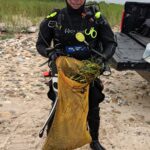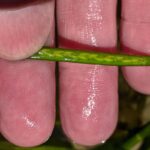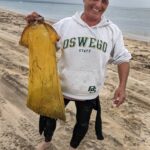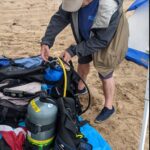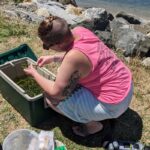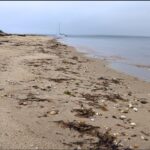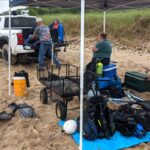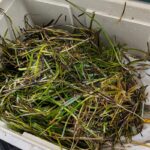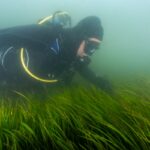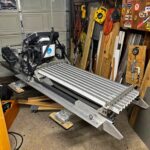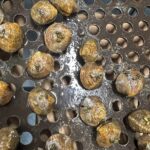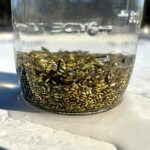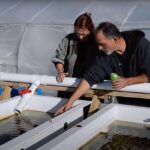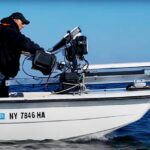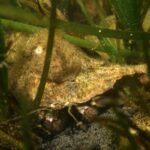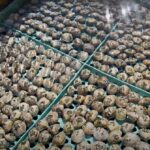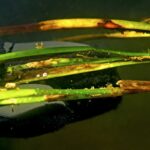“Never doubt that a small group of thoughtful committed individuals can change the world. In fact, it’s the only thing that ever has.” – Margaret Mead
We huddled inside our vehicles on a steamy, cloudy summer morning and waited for the thunderstorm to pass. After all, diving with thunder and lightning in the area is not a good idea.
Words & Photos by Michael Salvarezza & Christopher P. Weaver
Before long, the storm passed, and we were able to get to the task at hand. A small group of divers had gathered on the beach at Cedar Point Park on Long Island in New York to harvest the seeds of the local population of Eelgrass. The idea was to dive in the shallow Eelgrass beds, gather as many seeds as possible and bring them to the surface where they would be secured and used to help regenerate future populations of Eelgrass in areas where the groves of Eelgrass had been degraded or decimated.
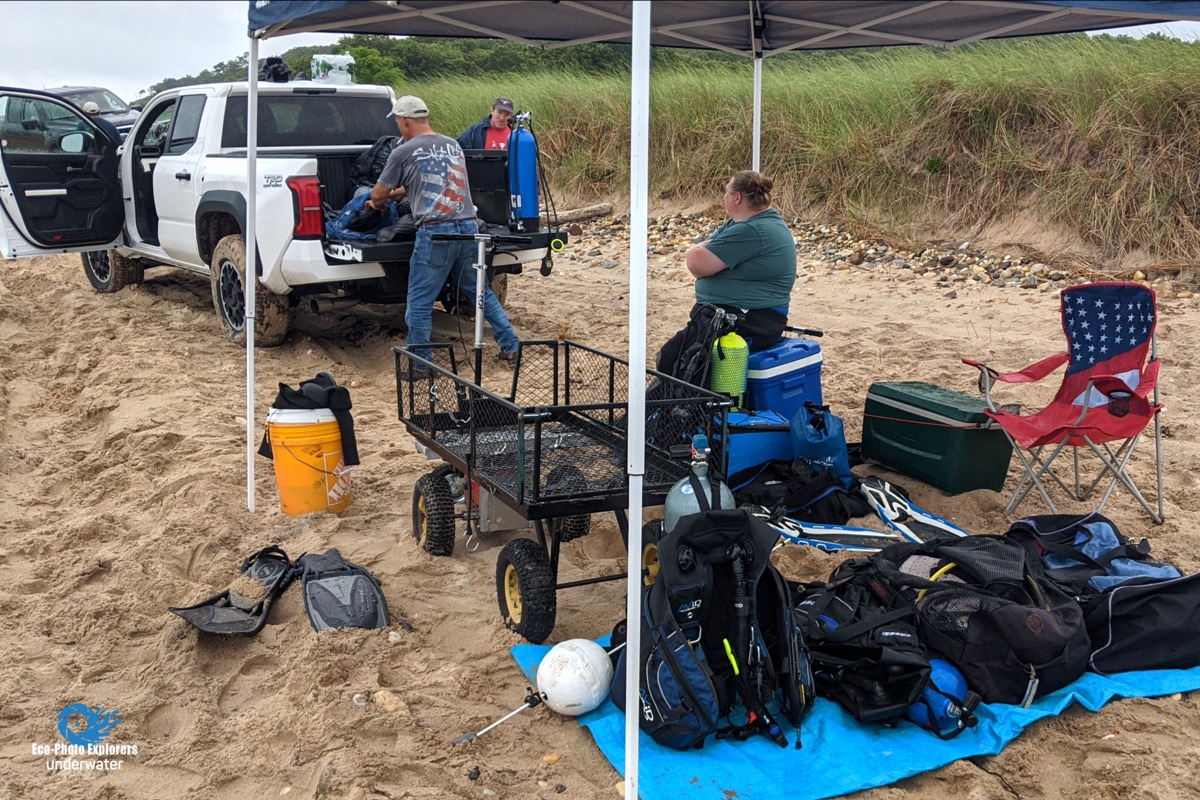
Divers set up camp on the beach at Cedar Point Park
It was a straightforward plan in support of a noble cause. And while there are Eelgrass restoration efforts conducted all the time around the world, this one was a bit unique. Spearheaded by Robert Vasiluth from Save Environmental, the crusade to save the Eelgrasses of Long Island involves an inventive approach to re-planting the grasses and utilizes the efforts of local volunteer divers to collect the seeds that are necessary for the entire process. With support from organizations such as the East Hampton Shellfish Hatchery, Cornell Cooperative Marine Program, Peconic Baykeeper, and Save the Sound, Vasiluth’s work relies on a grassroots volunteer diver effort to assist in the mission. For divers, it’s a way to dive with a purpose.
Species of Eelgrass are found in shallow waters in many parts of the world, ranging from the Arctic to the tropics. The only continent without these grasses is Antarctica. Beds of Eelgrass provide shelter and food for a plethora of diverse marine organisms, ranging from tiny invertebrates to crabs, fish, turtles, marine mammals and birds. Indeed, many species of marine life depend on these gardens of marine grasses
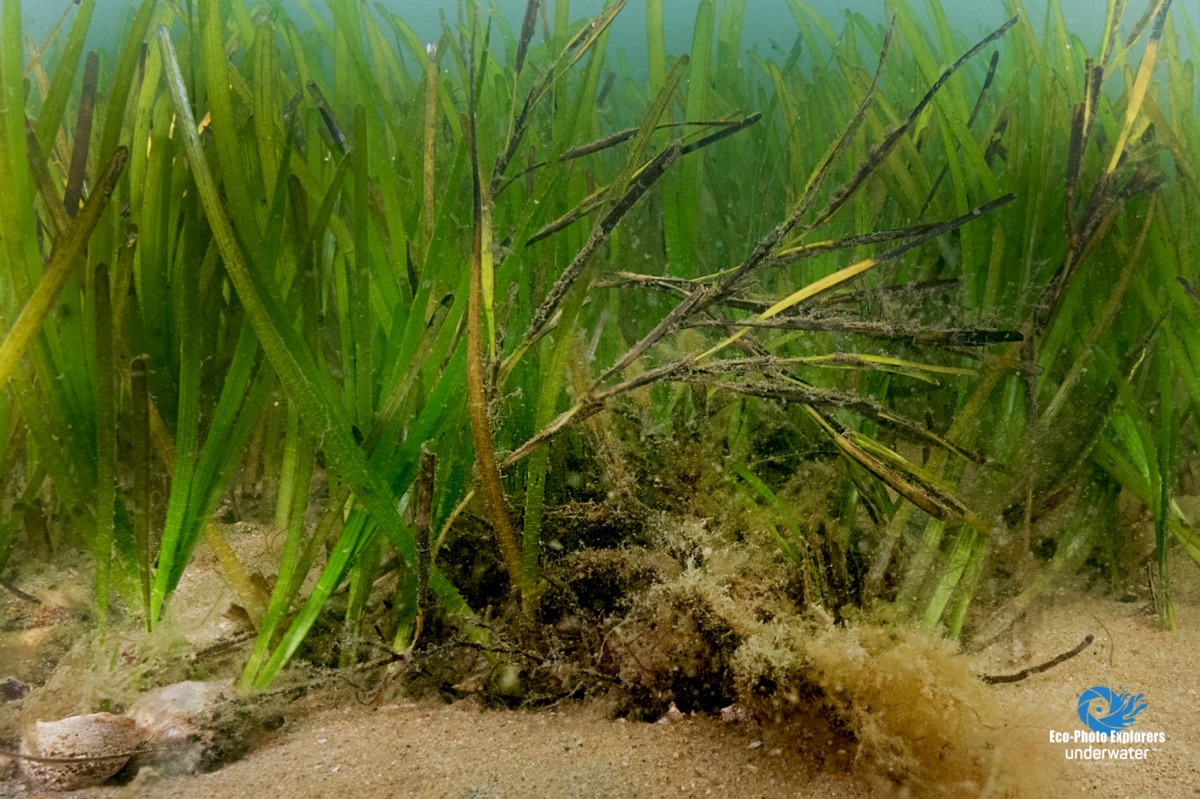
Eelgrass showing reproductive shoots
Eelgrasses have often been referred to as the “Lungs of the Sea”. Like other plants, Eelgrass uses photosynthesis to absorb carbon dioxide and generate oxygen. One square meter of Eelgrass can produce 10 liters of oxygen every day while capturing 740 pounds of carbon a year. Eelgrass also absorbs nutrients, slows the flow of water, captures sand and silt and helps to improve water clarity while reducing the effects of erosion. Since Eelgrass beds also help to buffer coastal areas from the ravages of storms, these ecosystems will become increasingly important as we struggle with the increase in storms relating to climate change.
Unfortunately, seagrasses, including Eelgrass, are in trouble. Globally, about 2 football fields worth of seagrass is lost every hour and It’s estimated that 30 percent or more of seagrass meadows have died off in the past century. Eelgrass is vulnerable to a variety of threats, including pollution from excessive nutrient runoff, dredging, wind and storm damage, degradation of the diversity of the marine ecosystem, rising temperatures and disease.

Eelgrass beds are home to numerous organisms, like this Hermit Crab
Some fast-growing beds of Eelgrass are able to rebound from disturbances, but many grow slowly over the course of centuries and are often slow to recover and are thus most vulnerable.
This is where the efforts to manually re-plant the Eelgrass beds come in. By harvesting viable seeds, nurturing them to begin to grow in tanks and other nursery grounds, and then re-planting them in areas where the beds are degraded or lost, the hope is that the once healthy populations of Eelgrass can be restored.
Here’s a video from Save the Sound that describes a new method to eelgrass restoration in the Long Island Sound.
We entered the water equipped with fine-meshed collection bags and immediately began scanning for seeds in water no deeper than 5-6 feet. At first, the amount of green Eelgrass blades looked beautiful. From the start of the dive, we observed some of the creatures that use these beds of grass as their home: a Blue Claw Crab half buried in the sandy substrate, tiny snails crawling along the blades of Eelgrass, a Norther Puffer fish darting in between the plants and seeking shelter. Clearly this was an environment teeming with life.
But where were the seeds we were looking for?
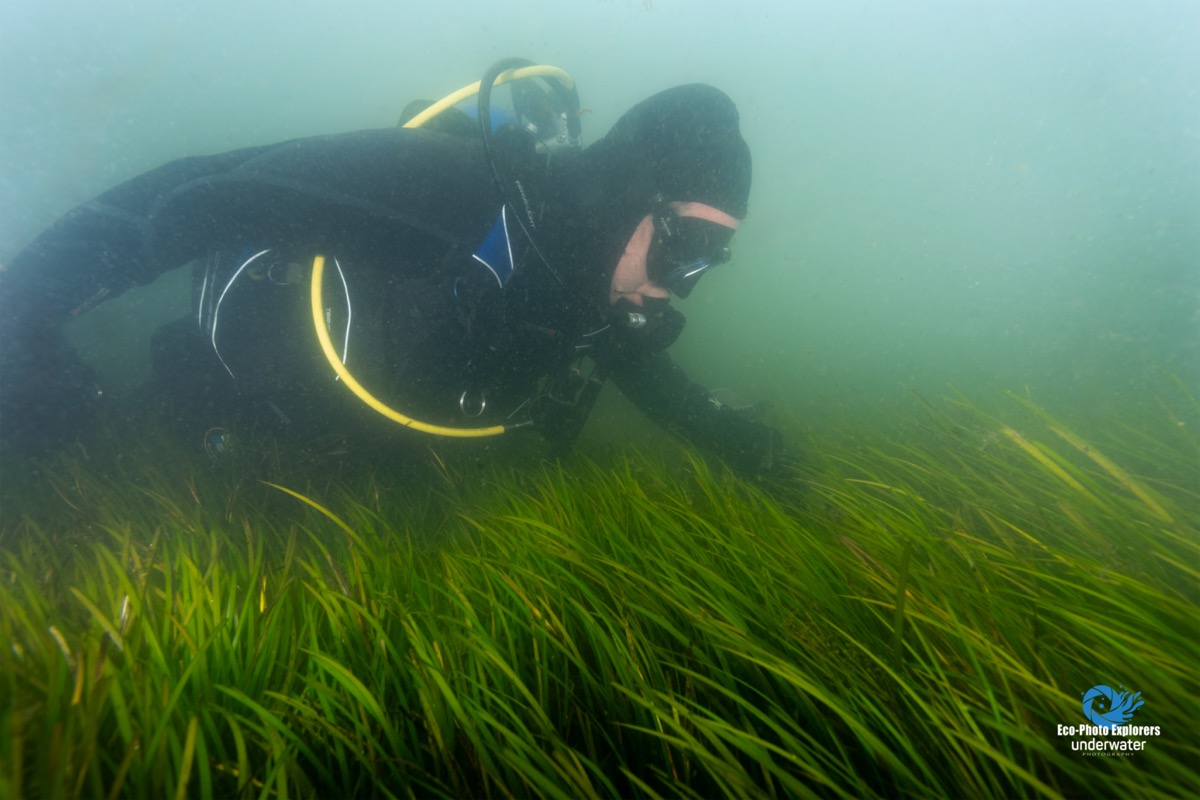
Diver searching for Eelgrass seeds
As first time Eelgrass seed harvesters, it took some time before we began to recognize the part of the plant that would be bearing seeds. Upon closer examination, though, we could see the rows of seeds which resembled tiny peas in a tiny pod! Now, the harvest was on!
Over the course of an hour or more, we sifted through the beds of green Eelgrass, only stopping when we spotted stalks likely to hold seeds. When we emerged from the water with full mesh bags, we were content in the knowledge we had helped gather hundreds of seeds to be used to replenish beds of Eelgrass elsewhere.
Similar dives have taken place around Long Island. Rob Vasiluth is constantly scouting the local Eelgrass beds and is able to assess when the Eelgrass is just about ready to release its seeds. Only then does he put a call for local divers to join a hastily organized collection dive, often with only a few days’ notice. While it sounds last-minute, it is the nature of the effort since the seeds should only be collected when they are close to being released by the mature plant.
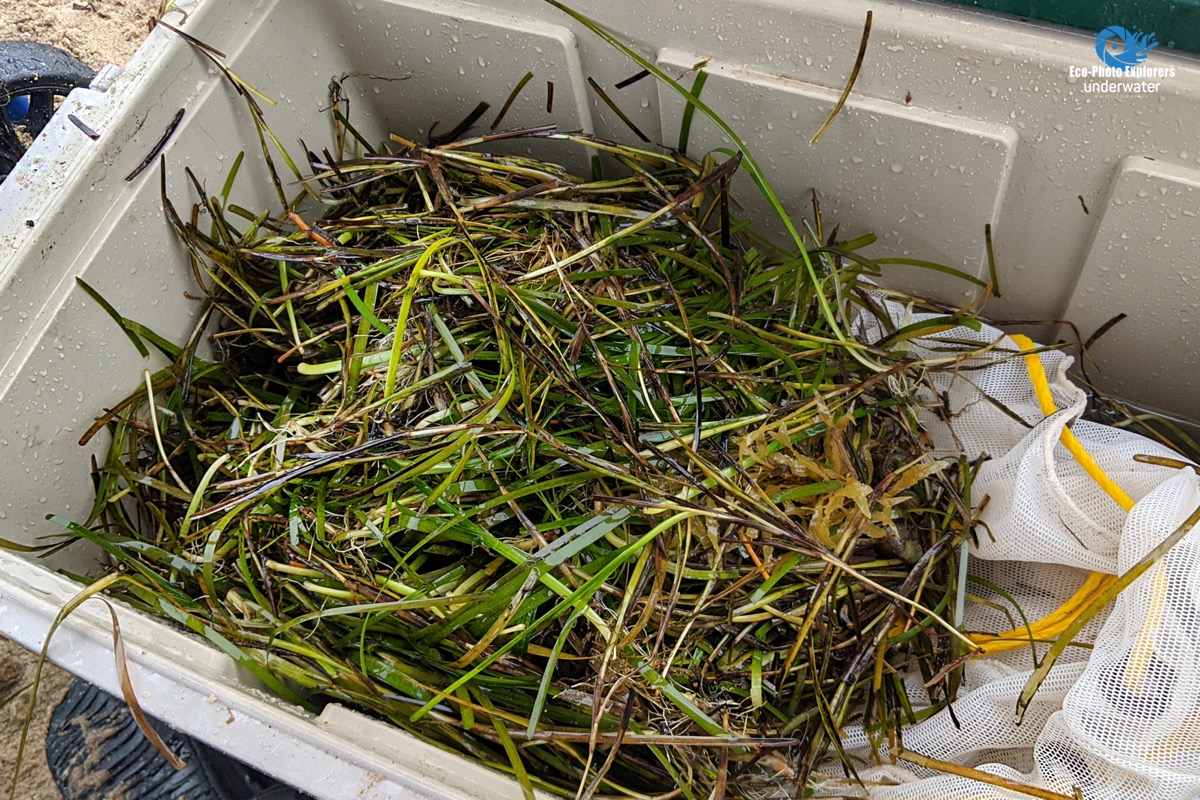
This collection of Eelgrass will yield many viable seeds
Dives at Oak Beach, Gardner’s Island, Orient Point and Fisher’s Island are some of the other areas where beds of Eelgrass on Long Island are being harvested by Vasiluth and his team of volunteers.
Once the seeds are returned to shore, Vasiluth works to help them germinate in controlled environments.
According to Vasiluth, eelgrass seeds are negatively buoyant, so when they fall from flowering shoots, they hopefully drop into holes in the sea bottom where they have a chance to grow.
Clams burrow under the sand to protect itself, and during this process, seeds can occasionally be drawn into these holes and once again have a chance to germinate. It’s this natural protection method of this animal that Vasiluth wants to mimic.
Volunteers, use a unique processed developed by Rob Vasiluth to help regrow eelgrass meadows in viable waters around Long Island. These volunteers use non-toxic and environmentally friendly glue to attach 5-10 eelgrass seeds to the shells of live clams, which look like sesame seeds on a hamburger bum.

Gluing the seeds to hard clam shells provides them a stable surface on which to germinate (Photo Courtesy of James Bertsch – Save the Great South Bay)
Vasiluth believes if each clam can carry at least ten attached seeds and just 10% of those viable seeds takes root and grow, that would mean one new eelgrass plant per clam can begin a new live in the surrounding waters off Long Island.
The organization has an ambitious goal for 2025: 1 million seeds planted across 10 acres!
According to the Great South Bay Ecosystem-based Management Plan (Final 2012), the following are the priority threats to Eelgrass.
- Global climate change
- Elevated nutrient loading
- Shellfish harvest methods
- Boating activities
- Shoreline armoring
- Toxins
*Eelgrass “is the foundation in the shallow sea,” notes Vasiluth. “It’s a nursery ground for juvenile fish. It’s where scallops can thrive. Eelgrass produces oxygen. It slows down erosion. It’s a natural buffer. It neutralizes acidification. It absorbs carbon.” But “95 percent of eelgrass in New York waters is gone,” he said.*

Volunteers attach Eelgrass seeds to the hard shells of living clams. (Photo Courtesy of James Bertsch – Save the Great South Bay)
With the help of local divers volunteering their time and diving with a purpose, in this case to collect viable Eelgrass seeds, they have a good chance of achieving that goal.
*Quotes excerpted from Fire Island News (07/08/22) from an article written by Karl Grossman.
Words & Photos by Michael Salvarezza & Christopher P. Weaver
- Long Island Divers Association President Barry Lipsky after his Eelgrass dive
- Eelgrass seeds ready for collection
- Robert Vasiluth with a haul of Eelgrass
- Eelgrass showing reproductive shoots
- Preparing to dive
- Examining the collected Eelgrass for seeds
- The shoreline at Cedar Point Park
- Divers set up camp on the beach at Cedar Point Park
- This collection of Eelgrass will yield many viable seeds
- Diver searching for Eelgrass seeds
- Eelgrass in collection cooler
- Divers setting up on the beach for an Eelgrass collection dive
- Robert Vasiluth crafted this custom device for distributing Eelgrass seeds into the water (Photo Courtesy of James Bertsch – Save the Great South Bay)
- Gluing the seeds to hard clam shells provides them a stable surface on which to germinate (Photo Courtesy of James Bertsch – Save the Great South Bay)
- Every Eelgrass seed helps in the process of regenerating Eelgrass beds (Photo Courtesy of James Bertsch – Save the Great South Bay)
- Volunteers attach Eelgrass seeds to the hard shells of living clams. (Photo Courtesy of James Bertsch – Save the Great South Bay)
- Divers collecting Eelgrass at Oak Beach Park (Photo courtesy of Ellen Verse)
- Ensuring the Eelgrass seeds thrive before planting in the ocean (Photo Courtesy of James Bertsch – Save the Great South Bay)
- Robert Vasiluth using his device to introduce Eelgrass seedlings to the open water (Photo Courtesy of James Bertsch – Save the Great South Bay)
- Eelgrass beds are home to numerous organisms, like this Hermit Crab
- Dozens of Hard Clams with Eelgrass seeds attached (Photo Courtesy of James Bertsch – Save the Great South Bay)
- Eelgrass blades with seeds underwater

